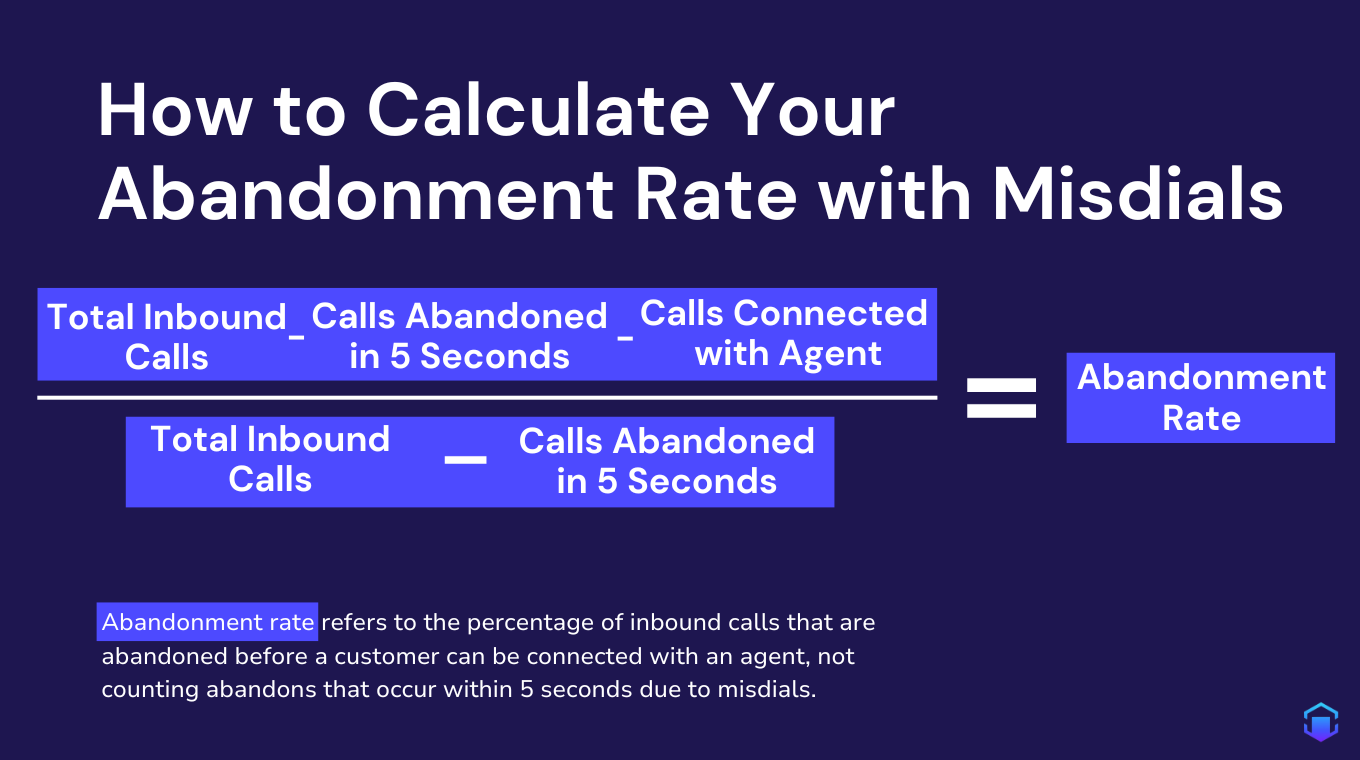How to Reduce Abandoned Calls in Call Centers
If you’re looking to improve your customer service, improving your call abandonment rate is a great place to start.

Are you losing customers?
That is to say, is your customer service experience causing customers to drop off before even being connected with an agent?
If you’re looking to improve your customer service, improving your call abandonment rate is a great place to start.
But before we get into our best tips to do that, let’s quickly cover abandonment rate is and why it’s so important.
What is an Abandoned Call?
An abandoned call is a customer who makes an inbound call to your customer service team and hangs up (i.e., abandons) before being connected with an agent.
What is a Call Abandonment Rate?
The callcenter abandon rate in customer service refers to the percentage of inbound calls or other requests that are abandoned before that customer can be connected with an agent.
Chances are, you’ve done it before in your own life. You get on a call only to be spun in circles trying to make your way through the automated phone system.
By the time you’re on hold, your patience is already thin and you hang up before an agent can get to you.
So, you drop off, thinking a little less highly of the company than before you began– or going with someone else entirely.
Why Is Call Abandonment Rate So Important?
Call abandonment rate is just one important metric, but it’s a vital one if you want to optimize the performance of your customer service.
In particular, that’s because a high call abandonment rate is a sign of something more systemic.
Sure, on a surface level, a high call abandonment rate means you may be losing those particular customers, or– at the very least– failing to deliver the level of service that you strive for.
But below that, a high call abandonment rate could also mean something bigger: that your systems are overcomplicated to the point of inefficiency.
In that case, something needs to change, or you risk the performance of your entire customer service team.
How to Calculate Call Abandon Rate
Now, let’s get into actionable steps.
Before you can start improving your call abandonment rate, you need to know what yours is.
To calculate your call abandonment rate, use this simple equation:
Take the total number of calls abandoned then divide it by the total number of calls received in that same time period.
Once you’ve gotten your number, simply multiply it by 100 to get your percentage rate.
A few things to keep in mind, however:
Your automated menu can impact your abandonment rate
Don’t overlook the importance of improving your interactive voice response (IVR) menus.
Sometimes, automated systems can be so overly complex that they repel customers and cause them to abandon their calls.
You’ll need to review your data carefully to not include calls you believe were misdials
This is generally done by removing any super short calls.
Which of these and how many will need to be your judgment call, just make sure you’re not potentially removing valid data to make your numbers look better than they really are.
For example, assume all calls dropped within the first 5 seconds are misdials. The equation for calculating your abandonment rate changes to the following:

What Should Your Abandonment Rate Be? (Industry Benchmarks)
Now, you know what your abandonment rate is (or you’re working on it).
But what should it be? When will you know you’ve gotten your abandonment rate down to an acceptable number?
According to recent Hubspot data, across all surveyed industries the average abandonment rate is between 5-8%.
As a first-level benchmark, you should shoot for an abandonment rate of below 8%.
However, with time the goal should be to get to 6% or below.
One final note: keep in mind that every industry is different. What may be a good abandonment rate in one industry could be barely cutting it in another.
For example, while the average abandonment rate is around 6%, that average across industries varies from 5.5-7.5%.
So, search out the most relevant data for your industry and try to factor that into your conclusions when testing and setting new goals.
How to Reduce Abandoned Calls: 3 Tips
Now that you have a benchmark, let’s talk about how to reduce call abandonment rate.
Here are some tips:
1. Implement a callback system
A recent addition to call centers, a callback system can be a breath of fresh air for customers who go into a CS call expecting to have to wait on hold.
A callback system can alleviate customer frustration and give those who would rather not wait on hold– in all likelihood, those most susceptible to abandoning the call– a way of contacting customer service without having to.
If you go this route, just make sure to properly set up your system to not mistakenly label these calls as abandoned.
2. Invest in self-service to reduce the total number of calls
This might sound a little backward, but it’s a way to attack the root of the problem and– in a way– kill two birds with one stone.
Here’s why: in a survey with BankMyCell.com, the vast majority of Gen Z and Millennial respondents stated finding phone calls a waste of time.
Both Millennials and Gen-Z prefer self-service options. So, what happens when you force them to solve their issue in a way that doesn’t work for them?
There’s no way to know for sure if a larger percentage of your abandoned calls are in fact from Gen Z or Millennials vs. other generations, but one thing is for certain.
If you provide convenient self-service options such as an easy-to-use knowledge base and convenient chat access (like Gleen AI’s powerful AI chatbot) on your website, you’ll offer more options for your customers to get the support they need quickly and conveniently.
Chances are, that will lead to a lower abandonment rate while also offering a slew of other efficiency improvements for your CS team as a whole.
3. Shift to a customer-in strategy
Have you ever called into your own call center? Do you know what it feels like to be a customer of your company?
If you haven’t, you may be missing a huge clue as to why your abandonment rate is higher than it should be.
When a customer calls into a call center an agent asks for certain information. This information is essential and allows that agent to assist the customer.
However, what happens when they need to be transferred to another person or department? Does that information go with them?
If that new agent must re-ask the same questions over again, your customers aren’t being put first– and they will become annoyed.
This is the typical call center experience, and it’s called a “function-out” model.
Instead, you need to shift to a “customer-in” model that puts the customer journey first.
In a customer-in model, you shift to thinking about what your customer’s experience is like when they call your CS team.
What would a seamless experience look like? How can you delight and create the fastest, most convenient, and most helpful experience possible?
More to the point: when your customers are handed off to another agent, what is the experience like for them?
You need a way for their information to transfer to the new agent. Make that customer feel as though the new conversation is a seamless continuation of their first one.
For calls, this is solved partly with a great CRM. For chat, you can take this a step further with a generative AI tool like Gleen AI.
Create a Seamless Customer Experience with Gleen AI
Shifting to a customer-in strategy is one of your best options if you want to not only improve your abandonment rate but your customer service experience as a whole.
Gleen AI seamlessly transfers conversations with your AI chatbot to live agents. The entire conversation is transferred from Gleen AI to your help desk solution, ensure maximum context and minimizing end user frustration.
The result is the ability to offer a completely personalized conversation for each and every customer without having to overhaul your systems or processes.
Schedule a demo to see how Gleen AI can improve your customer service, or create a free generative AI chatbot using Gleen AI now.



